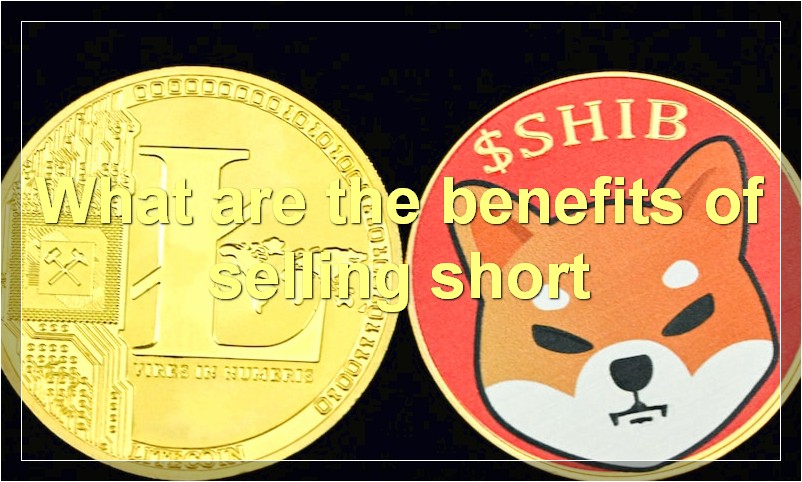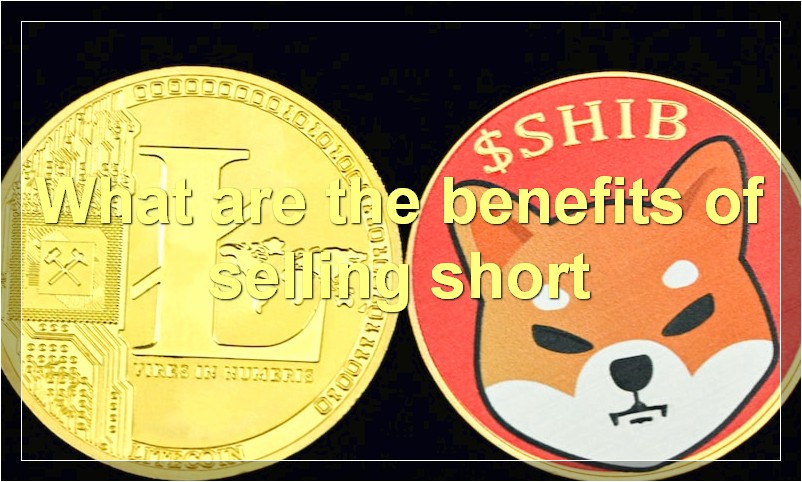If you’re looking to make a quick profit, selling short might be the right move for you. This comprehensive guide will show you everything you need to know to get started.
What does it mean to sell short
When you sell short, you borrow shares of the stock you hope to sell from somebody else, sell the stock, and hope the price falls so you can buy it back at a lower price and give the shares back to the person you borrowed them from. You’re betting that the price will go down.
If you’re right and the price falls, you make money. If the price goes up, you lose money. Selling short is riskier than buying stock because with stocks, the most you can lose is 100% of your investment. With selling short, there’s no limit to how much the price can go up and how much money you can lose.
What are the benefits of selling short

Short selling is the sale of a security that is not owned by the seller, in the hope that the price will fall so it can be bought back at a lower price and the difference pocketed.
A key advantage of short selling is that it allows you to profit from a stock price falling, rather than just rising. This means you can make money even in a falling market.
Another benefit is that it can be used to hedge against losses in your portfolio. For example, if you own shares in a company that you think is about to go bankrupt, you could sell them short to limit your losses.
Short selling also has the potential to generate higher returns than simply buying and holding a stock. This is because you are effectively levering your investment, which can lead to bigger profits if the stock price falls as you expect.
Of course, there are also risks associated with short selling. The most obvious one is that the price of the stock could rise instead of fall, in which case you would make a loss. There is also the risk that the company could go bankrupt before you have a chance to buy the shares back, which could result in a total loss of your investment.
Overall, short selling is a high-risk/high-reward strategy that can be used to generate profits in both rising and falling markets. However, it is important to understand the risks involved before entering into any short positions.
What are the risks of selling short
When an investor sells short, they are selling a security that they do not own and hope to buy the same security back at a lower price so they can have a profit. Shorting is a risky investment because the stock market is always moving up and down, so the price of the security the investor sold short could go up instead of down like the investor hoped. This would mean the investor would have to buy back the security at a higher price than they sold it short for and would have a loss. Another risk of selling short is that the investor might not be able to find someone who is willing to buy the security back from them when they want to exit their position. This could cause the investor to have to hold onto their short position for a long time, or even indefinitely if the price of the security never falls.
How do you know when to sell short
When you sell short, you borrow shares of the stock you hope to sell from somebody else, sell the stock, and hope the price falls so you can buy it back at a lower price and give the shares back to the person you borrowed them from.
Ideally, you want to wait until the stock price peaks before selling short. That way, you’re more likely to make a profit. However, timing the market is difficult, so you also need to be careful not to wait too long. If the stock price starts to drop and then rebounds, you could end up losing money.
What stocks are good for selling short
There are a number of stocks that are good for selling short. Some of the most popular include Apple, Google, and Amazon. These stocks tend to be very volatile, which makes them ideal for short selling. Other stocks that are good for selling short include Facebook, Tesla, and Netflix.
How do you pick the right moment to sell short

When it comes to selling short, timing is everything. You need to be able to identify when a stock is about to peak, so you can get in and out before the price starts to drop. Here are a few tips to help you pick the right moment to sell short:
1. Pay attention to the overall market trend. If the market is generally going up, there’s a good chance that individual stocks will continue to rise as well. On the other hand, if the market is heading down, it’s time to start looking for opportunities to sell short.
2. Study a stock’s past performance. Look for patterns of peaks and troughs to help you predict when the next peak might occur.
3. Use technical analysis. This involves looking at things like a stock’s moving averages and support and resistance levels. This can give you an idea of where the stock might head in the future.
4. Keep an eye on news events. Certain news events can trigger sharp movements in a stock’s price, so it’s important to be aware of what’s going on in the world.
5. Be prepared to act quickly. Once you’ve identified a potential opportunity to sell short, you need to be ready to act fast. If you wait too long, the opportunity could disappear.
By following these tips, you should be able to pick the right moment to sell short and make a profit.
What are the tax implications of selling short
When it comes to taxes, selling short can have implications. When you sell short, you are essentially borrowing shares of the stock you hope to sell from somebody else, selling the stock, and then returning the shares to the person you borrowed them from. The transaction is completed through a broker. Because you are borrowing shares, you may be subject to a margin call if the stock price falls below a certain level. This means that you will be required to put up more money to cover the loan.
If you are successful in selling the stock at a higher price than you paid for it, then you will have made a profit. This profit is subject to capital gains tax. However, if the stock price falls and you are unable to cover the loan, then you will have made a loss. This loss can be used to offset any capital gains you have made in other investments in that tax year.
In summary, selling short can have implications when it comes to taxes. You may be subject to a margin call and capital gains tax on your profits. However, losses can be used to offset capital gains in other investments.
How do you cover a short position
If you are short a position, it means you have sold securities you do not own and hope to buy the same securities back at a lower price so you can have a profit. To cover a short position, you must buy back the securities in the open market, and then you will have a long position again.
What happens if you can’t cover a short position
If you can’t cover a short position, you may be subject to a margin call. A margin call is when your broker asks you to deposit more money in order to cover your losses. If you don’t have the money to cover your losses, your broker may force you to sell your securities at a loss.
What’s the difference between selling short and going long
There are two types of trades that can be made in the stock market: going long and selling short. Going long is when an investor buys a stock with the hope that it will increase in value so that they can sell it at a higher price and make a profit. Selling short is when an investor sells a stock that they do not own and hope to buy the same stock back at a lower price so they can have a profit.

